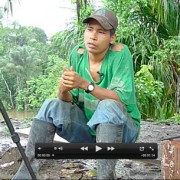Marilu’s Journey To Medical Care
It’s my pleasure to introduce you to Mayer. Mayer and his wife Marilu have two children. We greatly appreciate Mayer taking time off of work to recount his wife’s third pregnancy with us.
When you travel through this part of the world you will see a lot of buildings with thatched roofs. The best of these roofs will withstand the daily torrential rains for seven years. The expertise to make such a roof is passed from master to apprentice. On the Cochiquinas river, Mayer is that master.
Three years ago Mayer’s wife, Marilu, was pregnant with their third child. She was also struggling with a mild case of malaria. It wasn’t mild in the eyes of Marilu. She was outspoken about the severity of her malaria with Mayer. But she didn’t look that sick, and how many times can someone be taken seriously if they piss and moan about cold after cold. It’s a rainforest here. It’s really humid and bronchial infections are as common as people sneezing when flowers begin to bloom back in South Carolina.
The sole bread earner can hardly be expected to play nursemaid every time his hypochondriac of a wife comes down with a cold.
Mayer goes back into the jungle to continue making thatched roofs.
At the time we first met Mayer he was working to fulfill an order for 100 thatchings. That’s enough material to cover a comfortable family house in the suburbs.
Unfortunately Marilu’s health continued to deteriorate while Mayer was out of town. Her father saw the urgency of the situation and took off to find Mayer.
Getting Marilu the help she needed was now the entire family’s highest priority. The following morning Marilu and Mayer paddled their dugout canoe eight hours to the mouth of the river, seeking help from a shaman. The dire nature of this situation is readily apparent to everyone. Mayer recounts to us his wife’s words, “you’ve killed me Mayer. You left me when I needed help and now you’ve killed me.”
At the point where the Cochiquinas and the Amazon River meet they find a shaman. She takes Mayer aside for further consultation.
Note: We haven’t talked with this shaman yet. I can only tell you what Mayer has shared with us.
“While you were away working another man has fallen in love with your wife. He wished you would die and sought the help of a different shaman. A curse that was intended for you was accidentally placed on your wife. Now I’m unable to help her.”
The nearest help from this point will take over a day of paddling to reach. Despite that tail of jealousy, the people in this area do take care of one another. Victor (I hope to have the actual name of this person for you soon) shuttled Mayer and Marilu down the Amazon to the nearest medical center in the village of San Francisco in his peki-peki.
Marques is the medical technician in San Francisco. Like the shaman, Marques did not feel qualified enough to help Marilu.
With the continued generosity of Victor, the peki-peki’s owner, they continue their journey to Pevas.
Pevas is the main city for over 100 communities. There are 6,000 people in Pevas and the hospital has a staff of thirty.
No different than the shaman and medical technician, the doctors in Pevas were not capable of providing the care that Marilu required. They would need to travel to Iquitos.
The journey from Pevas to Iquitos:
A. Several days via peki-peki (substantial canoes with outboard engines).
B. twenty-four hours via colectivo (large boats transporting everything from people and chickens to bananas).
C. six hours via rapido (we call them speed boats).
Question: How expensive is too expensive to save your wife’s life?
Answer: $192
Facts from the rainforest:
A. Mayer earns 50 cents for each 12 foot length of thatching.
B. Annually Mayer earns roughly $400.
C. That $400 feeds their two kids, parents, and Marilu’s sister.
D. In Pevas a gallon of fuel is over four dollars.
E. A rapido consumes eight gallons of fuel per hour.
F. The trip from Pevas to Iquitos is six hours.
While Marilu is receiving medical care Mayer seeks funds from the mayor of Pevas. For emergency situations, such as this one, the mayor is able to provide funding for fuel.
The following morning Mayer and Marilu are on a rapido headed to Iquitos. Marilu’s harsh words soften on this final leg of their journey, “This situation is not your fault Mayer. You need to take care of our kids. They are all that matter. Take care of our kids.”
Marilu dies en route to Iquitos. Their unborn child is trapped and dies within her.
Mayer continues to make thatched roofs. He is not always alone in the jungle. “My children are now apprenticing with me. They are not ready to make thatching on their own. I am teaching them slowly and carefully.”
Travel Time To Medical Care In The Amazon Rainforest
* 8 hours in a dugout canoe
* 3-4 hours in a peki-peki from the Cochiquinas river to the medical center in the village of San Francisco
* 6 hours in a peki-peki from San Francisco to the hospital in Pevas
* 6 hours in a rapido from Pevas to Iquitos
TOTAL TRAVEL TIME: 23-24 hours to proper medical care
* Without the support of http://www.foreigntranslations.com and generous individual donors this work would not be possible.






Very bittersweet story. I appreciated reading about the various textures of it, including the folkloristic aspects. It’s a good reminder how much the bare facts of medical care can get woven up with people’s belief systems, not just here but everywhere, even in industrialized cultures.